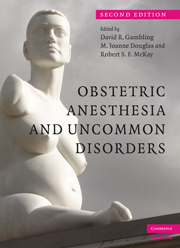Book contents
- Frontmatter
- Contents
- List of plates
- List of contributors
- Preface
- Section 1 Cardiovascular and respiratory disorders
- Section 2 Musculoskeletal disorders
- Section 3 Nervous system disorders
- 9 Disorders of the central nervous system in pregnancy
- 10 Spinal cord disorders
- 11 Peripheral neuropathy
- 12 Chronic pain in pregnancy
- Section 4 Metabolic disorders
- Section 5 Other disorders
- Index
- Plate Section
- References
9 - Disorders of the central nervous system in pregnancy
from Section 3 - Nervous system disorders
Published online by Cambridge University Press: 19 October 2009
- Frontmatter
- Contents
- List of plates
- List of contributors
- Preface
- Section 1 Cardiovascular and respiratory disorders
- Section 2 Musculoskeletal disorders
- Section 3 Nervous system disorders
- 9 Disorders of the central nervous system in pregnancy
- 10 Spinal cord disorders
- 11 Peripheral neuropathy
- 12 Chronic pain in pregnancy
- Section 4 Metabolic disorders
- Section 5 Other disorders
- Index
- Plate Section
- References
Summary
Introduction
Disorders of the central nervous system (CNS) during pregnancy remain a common cause of maternal morbidity and mortality. Central nervous system disease was responsible for 34 of the 90 indirect causes of death during the 1997–1999 Confidential Enquiry into Maternal Deaths in England and Wales. Intracranial hemorrhage was responsible for 21 of these deaths. Some disease processes pre-date pregnancy, such as epilepsy, Parkinson disease, multiple sclerosis, intracranial lesions, benign intracranial hypertension, or migraine. Other conditions have an increased incidence during pregnancy, for example cerebrovascular disorders, including hemorrhagic or vaso-occlusive strokes.
Few centers have extensive experience treating these CNS disorders, so management is based on isolated case reports, basic principles, and common sense. Maternal vegetative states and brain death situations present medico-legal and ethical dilemmas. Issues important to the care of the parturient with a CNS disorder include:
the pathophysiology of the lesion
the impact of pregnancy on the lesion
impact of medical management, monitoring, and surgery on the fetus
the potential for aortocaval compression from lead shielding during diagnostic radiological procedures
gastric aspiration during pregnancy in mentally obtunded patients
maternal versus fetal priority with respect to surgical plan, timing, and route of delivery
communication and coordination among the patient, her family, and the medical team (neurologist, neurosurgeon, obstetrician, anesthesiologist, medical consultants, and nursing staff).
Diagnostic tests
A number of intracranial conditions can produce similar signs and symptoms in the parturient (see Table 9.1). A high index of suspicion for unusual conditions is important because aggressive treatment greatly affects outcome.
- Type
- Chapter
- Information
- Obstetric Anesthesia and Uncommon Disorders , pp. 167 - 190Publisher: Cambridge University PressPrint publication year: 2008
References
- 1
- Cited by

